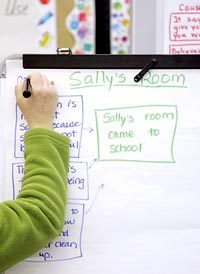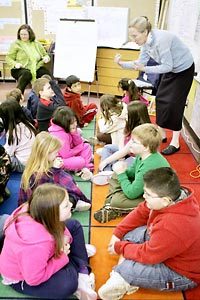Revving up reading in Marysville schools

On a recent Monday morning at Cascade Elementary School in the Marysville School District, veteran teacher Lauri Hagglund engaged in a timeless activity — reading aloud to her second-grade students.
The children sit cross-legged or up on their knees on brightly colored carpet squares. The teacher stops at the end of each page to display the book's illustrations.
But pull the lens back a few feet and the classroom becomes a laboratory for practicing the latest approaches to literacy. A reading coach sits a few feet away from Hagglund, charting plot details about cause and effect from a story involving a very tidy cat and a very messy one.
At the edge of the reading carpet, several observers, including the district's superintendent, assistant superintendent and school principal, take notes.
When Larry Nyland took over the district in 2004, the new superintendent launched an initiative focused on strengthening students' reading skills. Standardized test scores in the district were among the county's lowest, and classroom assessments showed that even students who read stories at grade level sometimes struggled to understand their science and history books.
The district developed focused training for teachers on ways they could help students more readily grasp meaning and deepen their thinking about books. Principals learned how to observe and give feedback to their teachers. Reading coaches at every elementary school worked with struggling students.
In January, they began presenting lessons in classrooms while teachers observed both the techniques and their effectiveness with the children.
The elementary classrooms were also re-imagined so that each had a communal-reading area where the children could sit comfortably and closely to the spoken words.
District administrators began making regular visits to classrooms to gauge how the training might be furthered or refined. Last year, Nyland and his staff made 500 such visits.
For many teachers, it was the first time they'd been regularly observed and given feedback since they were students, Nyland said. And some were wary of the approach.
"Up until now, administrators were only in the classroom to evaluate teachers," Nyland said. "We had to show them our focus was on improving student learning. It's like athletes watching game film to see what they're doing and what they might want to change."
Back in the classroom, the school's reading coach, Leanne Rivas, asks the children how the two cats in "The Tale of Two Kitties" feel about each other. In the illustration, they sit at opposite ends of a long fence, their tails toward each other.
"Turn and talk," Rivas instructs, and on cue, the students turn to a partner to discuss the cats' mutual disdain. The approach seems more typical of a grown-up reading group than an elementary-school classroom, but Assistant Superintendent Gail Miller said that by recalling details, summarizing their thoughts and finding evidence for their views, the students go more deeply into the text and practice skills they'll use all of their reading lives.
Some shortcomings of the approach are quickly apparent. Confident and chatty children give their opinions first. When Rivas counts backward — three, two, one, time for talk is done — several quieter students haven't said a word.
Another challenge emerges. Rivas is drawing boxes around the plot elements to help illustrate cause-and-effect. Writing the students' own words down also helps them summarize their ideas and gives kids just learning English a chance to see their spoken words in print, but her examples of cause-and-effect get a little lost in all the plot elements.
Still, the pedagogy doesn't interrupt the students' enjoyment of the book. Most laugh and point as the cats, Fluffy and Scruffy, team up to rout some impudent mice.
About a half-hour after it began, what the district calls a reading "walk-through" ends.
The school administrators regroup with the reading coach in the office of Cascade's principal, Chris Sampley. Miller, who previously worked with student teachers at Seattle Pacific University, asks Rivas to recall the purpose of the lesson and how it went.
Rivas says she realizes she strayed from the initial goal and isn't sure what the students learned.
The observers are less hard on her than she is on herself. Miller reminds her how at different points she guided the students back to the text, the same strategy a more experienced reader would use to search for meaning or relationships.
Rivas, in hindsight, thinks "The Tale of Two Kitties" was better suited to demonstrate compare-and-contrast than cause-and-effect. The observers agree that one challenge of their literacy effort is that each book has to be dissected for its best lessons in advance.
At lunch time, she'll sit down with the classroom teacher and review any thoughts both of them have.
A week later, Rivas and Hagglund are teamed up again with another book. Some adjustments are immediately evident. The students are instructed to take turns talking about the book so no one is left out. Rivas is also more deliberate about what she chooses to chart, emphasizing cause-and-effect, which she notes is both a life lesson and a question likely to appear on the Washington Assessment of Student Learning.
After class, Hagglund talks about the literacy initiative and how, after 27 years in the classroom, it's changing her teaching. More than anything, she says, the literacy initiative has reminded her what it's like to be a student again, to be asked to do something new and hard.
"It puts us all in the place of being learners," she said.
Lynn Thompson: 425-745-7807 or lthompson@seattletimes.com
